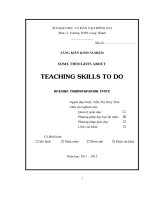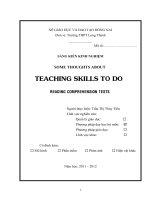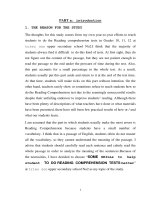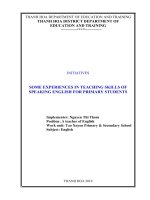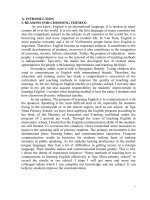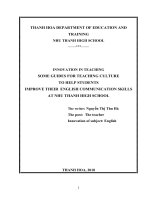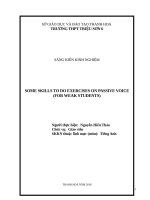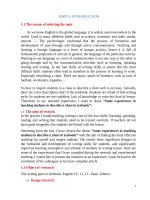skkn SOME THOUGHTS ABOUT TEACHING SKILLS TO DO READING COMPREHENSION TESTS
Bạn đang xem bản rút gọn của tài liệu. Xem và tải ngay bản đầy đủ của tài liệu tại đây (305.14 KB, 25 trang )
SỞ GIÁO DỤC VÀ ĐÀO TẠO ĐỒNG NAI
Đơn vị: Trường THPT Long Thành
_____________
Mã số:………………………..
SÁNG KIẾN KINH NGHIỆM
SOME THOUGHTS ABOUT
TEACHING SKILLS TO DO
READING COMPREHENSION TESTS
Người thực hiện: Trần Thị Thủy Tiên
Lĩnh vực nghiên cứu:
Quản lý giáo dục:
Phương pháp dạy học bộ môn:
Phương pháp giáo dục:
Lĩnh vực khác:
Có đính kèm:
Mô hình
Phần mềm
Phim ảnh
Năm học: 2011 – 2012
1
Hiện vật khác
SƠ LƯỢC LÝ LỊCH KHOA HỌC
______________
I.
THÔNG TIN CHUNG VỀ CÁ NHÂN:
1. Họ và tên: TRẦN THỊ THỦY TIÊN
2. Ngày tháng năm sinh: 01 / 01 / 1968
3. Nam, Nữ: Nữ
4. Địa chỉ: Tổ 19, Khu Phước Hải, Thị trấn Long thành, huyện
Long Thành, tỉnh Đồng Nai
5. Điện thoại: 0613844281 (CQ); 0613 546764 (NR)
6. Chức vụ: Giáo viên Trung học phổ thong
7. Đơn vị công tác: Trường THPT Long Thành
II.
TRÌNH ĐỘ ĐÀO TẠO:
- Trình độ chuyên môn cao nhất: Cử nhân tiếng Anh
- Năm nhận bằng: 1990
- Chuyên ngành đào tạo: Tiếng Anh
III.
KINH NGHIỆM KHOA HỌC:
- Lĩnh vực chuyên môn có kinh nghiệm: Giảng dạy
- Số năm có kinh nghiệm: 20 năm
- Các sáng kiến kinh nghiệm đã có trong những năm gần đây:
Some thoughts about teaching vocabulary in grade 10 in
High Schools
Some thoughts about teaching reading skill in High
Schools
2
Name of Experience Initiative:
SOME THOUGHTS ABOUT
TEACHING SKILLS TO DO
READING COMPREHENSION TESTS
3
PART 1
I. BACKGROUND AND THE REASON FOR THE STUDY
The impetus for this study comes from my own year-to-year efforts to teach
students to do the Reading comprehension tests in Grades 10, 11, 12 in Long
Thanh High School.
I feel that the majority of students always find it hard to do this type of tests. At
first sight, they do not figure out the content of the passage, but they are not
patient enough to read the passage to the end under the pressure of time during the
test. Also, this part accounts for a small percentage in the whole test. As a result,
students usually put this part aside and return to it at the end of the test time. At
that time, students will make ticks on this part without intention.
On the other hand, teachers rarely show or sometimes refuse to teach students how
to do the Reading Comprehension test due to the seemingly unsuccessful results
despite their unfailing endeavor to improve students’ reading. Although there have
been plenty of descriptions of what teachers have done or what materials have
been presented, there have still been few practical results of how or / and what our
students learn.
To help students of High School confidently come in the coming final test, Thanh
Nien Paper holds a live consultancy instructing students to revise for the final
exam with the topic “To get good mark in the GCSE examination” at 2p.m. on
April 3rd, 2012.
In that talk, Ms. Tran Thi Huyen Thanh – Head of English Section, Nguyen Thi
Minh Khai High School, Ho Chi Minh City assumed that the part in which
students usually make the most errors is Reading Comprehension because students
have a small number of vocabulary. She said that in a passage of English, students
often do not master all the vocabulary, so they cannot understand the meaning of
the passage. She advises that students should carefully read each sentence and
calmly read the whole passage in order to analyze the meaning of the sentences.
Owing to the necessities, I have made up my mind to choose “Some thoughts
about teaching skills to do Reading comprehension tests” as my topic of the
study.
4
II. AIM OF THE STUDY:
With the above mentioned reasons in mind, I have the specific aims as follows:
1. To help students improve the skills of doing reading comprehension tests.
2. To encourage students to confidently cope with this type of tests so as to
complete the tests at best they can.
3. To encourage students to get full mark on this part of test.
III. SOURCE OF THE STUDY:
The materials that have been greatly valuable to my study are from the book of
Vietnam National University Ho Chi Minh City, University of Science - Toefl,
Preparation Course, Reading Comprehension. Besides, the examples to illustrate
my thesis are all in the textbooks - Tiếng Anh 10, 12 – Nhà xuất bản Giáo dục, and
also from the latest one-period tests as well as the first and second semester tests.
5
PART 2
I. SITUATION JUDGMENT:
As regards the teaching of reading, I do not totally deny the energies the teachers
in explaining the text. However, in discussion with the teachers in our school, I
feel that our investment of energies in teaching the reading part is meaningless. It
is because most students learn in advance from the Instruction Books the content
of the text in Vietnamese, not in English, while teachers take no notice of that.
Little by little, students get a habit of being unable to read the English passages by
themselves. They always expect their teachers to translate the passages into
Vietnamese, or choose the options with no intention.
As for teachers, after asking students, especially good students, to translate the
text, or doing it for the worse students, teachers let students do the tasks without
giving any explanation. Consequently, students get confused and do not know
what they need to find from the text and how to choose the answers. In the end,
students refuse to read the passage or read them without intention, then choose the
answers randomly and never know whether their answers are right or not. As a
result, students put no efforts into the part of Reading Comprehension.
I always see that the greatest problem students face in any English paper is
Reading Comprehension. Students either spend much time on it without knowing
for sure the answers or do it without intention. As for me, I would like to present
in this paper some following skills to help my colleagues teach students how to get
over this problem so that the latter can do this part more easily and exactly. I hope
that my topic “Some thoughts about teaching skills to do Reading
comprehension tests” can result in effective ways in teaching students how to
complete their tests perfectly.
II. TEACHING SKILLS TO DO READING COMPREHENSION TESTS:
Each reading passage is often followed by 5 questions of reading comprehension
and vocabulary. Topics of the reading passage are varied, but they are often
informational subjects such as history, literature, art, architecture, geology,
geography, and astronomy. Time is definitely a factor in the Reading
Comprehension.
Some students, especially average students, note that they are unable to finish all
the questions in this section. Others cannot understand what the passage is about,
6
so they do without intention and don’t know surely if their answer is true.
Therefore, they need to make the most efficient use of their time in this section to
get the highest score. The following method is the best way of attacking a reading
passage to get the most questions correct in a limited amount of time.
STRAGIES FOR THE READING COMPREHENSION QUESTIONS
1. Skim the reading passage to determine the main idea and the overall
organizations of ideas in the passage. You do not need to understand every
detail in each passage to answer the questions correctly. It is therefore a waste
of time to read the passage with the intent of understanding every single detail
before you try to answer the questions.
2. Look ahead at the questions to determine what types of questions you must
answer. Each type of question is answered in a different way.
3. Find the section of the passage that deals with each question. The question –
type tells you exactly where to look in the passage to find correct answers.
- For main ideas questions, look at the first line of each paragraph.
- For directly and indirectly answered detail questions, choose a key word in
the question, and skim for that key word (or a related idea) in order in the
passage.
- For vocabulary questions, the questions will tell you where the word is
located in the passage.
- For overall review questions, the answers are found anywhere in the
passage.
4. Read the part of the passage that contains the answers carefully. The answer
will probably be in the same sentence (or one sentence before or after) the key
word or idea.
5. Choose the best answer to each question from the four answer choices listed in
the textbook. The best answer can be chosen according to what is given in the
appropriate section of the passage, eliminate definitely wrong answers, and
mark the best guess on the answer sheet.
The following skills will help students to implement these strategies in the
Reading passage of the test.
A. QUESTIONS ABOUT THE IDEAS OF THE PASSAGE _______________
It is very common for reading passages of the test to have questions about the
overall ideas in the passage. The most common type of question asks about the
main idea, topic, title, or subject.
7
Skill 1. Answer main idea questions correctly.
Students may be asked to identify the topic, subject, title, primary idea, or main
idea. These questions are all really asking what primary point that the author is
trying to get across in the passage, and it is not difficult to find the main idea by
studying the topic sentence, which is most probably found at the beginning of a
paragraph.
If the passage consists of only one paragraph, students should study the beginning
of that paragraph to determine the main idea. If a passage consists of more than
one paragraph, students study the beginning to determine the main idea.
Example 1. In the Second Semester Test, Grade 12, year 2010-2011, Code AV
121, the Reading comprehension is that:
The Asian Beach Games is a multi – sport event held every two years among
athletes representing countries from Asia. The games are regulated by the
Olympic Council of Asia. The first Games were held in 2008 in Bali, Indonesia.
This Games will be composed of sports with strong television appeal such as
windsurfing, kite boarding, swimming, beach volleyball, beach handball, beach
soccer, and dragon boat racing.
The Asian Indoor Games is a multi – sport event held every two years among
athletes representing countries from Asia. The Games are regulated by the
Olympic Council of Asia. The first Games were held in Bangkok, Thailand.
This Games will be composed by sports with TV broadcasting potential and not
included in the Asian Games and Winter Asia Games Programs and are not
Olympic sports. The sports program will comprise from six to eight exciting
sports with strong television appeal, including electronic sports, extreme sports,
aerobics, acrobatics, indoor athletics, dance sports, inline hockey, fin swimming,
and 25 meters short course swimming.
Question 27. The passage is about …………………………
A. The Asian Beach Games and the Asian Indoor Games.
B. The Olympic Council of Asia.
C. The Asian Games and Winter Asian Games Programs.
D. The Asian Indoor Games and Winter Asian Games Programs.
In the above given passage, there are four paragraphs. Students should be sure to
read the first sentence of each paragraph to determine the subject, title, or main
idea. In Example 1, the first sentence of the first paragraph of this passage
discusses the Asian Beach Games, and the second paragraph begins with “this
Games”, which means that it is about the Asian Beach Games. The first sentence
8
of the third paragraph tells of the Asian Indoor Games, about which the fourth
paragraph tells, also beginning with “this Games”. So the whole passage discusses
the two kinds of games: the Asian Beach Games and the Asian Indoor Games.
Therefore, the best choice is answer A.
The following chart outlines the key information that students should remember
about main idea questions:
MAIN IDEA QUESTIONS
HOW
TO What is the topic of the passage?
IDENTIFY THE What is the subject of the passage?
QUESTIONS
What is the main idea of the passage?
What is the author’s main point in the passage?
With what is the author primarily concerned?
Which of the following would be the best title?
WHERE TO FIND The answer to this type of question can generally be
THE ANSWER
determined by looking at the first sentence of each paragraph.
HOW TO
1. Read the first line of each paragraph.
ANSWER THE
2. Look for a common theme or idea in the first lines.
QUESTION
3. Pass your eyes quickly over the rest of the passage to
check that you really have found the topic sentence(s).
4. Eliminate any definitely wrong answers and choose the
best answer from the remaining choices.
B. DIRECTLY ANSWERED QUESTIONS _____________________________
Skill 2. Answer stated detail questions correctly.
A stated detail question asks about one piece of information in the passage rather
than the passage as a whole. The answers to these questions are generally given in
order in the passage, and the correct answer is often a restatement of what is given
in the passage. This means that the correct answer often expresses the same idea as
what is written in the passage, but the words are not exactly the same.
Example 2: In English 10, page 45 and 46, Unit 4 “Special Education”, Part
Reading, the second paragraph:
At first, there was a lot of opposition from the parents of the disabled children.
They used to believe that their children could not learn anything at all. In the first
week, only five children attended the class. Gradually more children arrived. Their
parents realized that the young teacher was making great efforts to help their poor
kids.
9
Task 2:
Question 2: At first the parents were ____________ the idea of sending their
children to the special class.
A. interested in
B. opposed to
C. satisfied with D. worried about
Since in the first sentence of the paragraph, there is the noun “opposition”, we can
see from the four answers the verb “opposed” in the answer B, they are in a
family. So the answer B is the best one.
The following chart outlines the key information that students should remember
about stated detail questions:
STATED DETAIL QUESTIONS
HOW TO
According to the passage, …
IDENTIFY THE
It is stated in the passage …
QUESTION
The passage indicates that …
The author mentions that …
Which of the following is true …?
WHERE TO FIND The answers to these questions are found in order in the
THE ANSWER
passage
HOW
TO
1. Choose a key word in the question.
ANSWER
THE
2. Skim in the appropriate part of the passage for the key
QUESTION
word or idea.
3. Read the sentence that contains the key word or idea
carefully.
4. Look for the answer that restates an idea in the
passage.
5. Eliminate the definitely wrong answers and choose the
best answer from the remaining choices.
Skill 3. Find “unstated” details.
Students will sometimes be asked to find an answer that is not stated or not
mentioned or not true in the passage. This type of question really means that three
of the answers are stated, mentioned, or true in the passage, while one answer is
not. The actual job is to find the three correct answers and then choose the letter of
the one remaining answer. The teacher asks students to notice that there are two
kinds of answers to this type of question:
1) There are three true answers and one answer that is not discussed in the
passage.
10
2) There are three true answers and one that is false according to the passage.
Example 3: In English 12, page 163 and 164, Unit 15 “Woman in Society”, Part
Reading, the last paragraph:
Today, although their status varies in different countries, women in most parts of
the world have gained significant legal rights. The most important of these are: the
right to have equal work opportunities and pay to men, the right to vote, and the
right to formal education.
Task 2:
Question 5: Which of the following is NOT mentioned in the last paragraph as one
of women’s legal rights today?
A. the right to hold property
B. the right to equal pay
C. equal employment opportunity rights
D. the right to vote
The question asks for the one answer that is not mentioned, so three of the answers
are listed in the passage and one is not. Since the right to equal pay, equal
employment opportunity rights, the right to vote, are listed in the passage, answers
B, C, and D are incorrect. However, the right to hold property is not listed in the
passage, so answer D is the best answer to this question.
The following chart outlines the key information that students should remember
about “unstated” detail questions:
HOW
TO
IDENTIFY THE
QUESTION
WHERE TO FIND
THE ANSWER
HOW
TO
ANSWER
THE
QUESTION
“UNSTATED” DETAIL QUESTIONS
Which of the following is not stated …?
Which of the following is not mentioned …?
Which of the following is not discussed …?
All of the following are true except …?
The answers to these questions are found in order in the
passage.
1. Choose a key word in the question.
2. Scan in the appropriate place in the passage for the key
word (or related idea).
3. Read the sentence that contains the key word or idea
carefully.
4. Look for answers that are definitely true according to
the passage. Eliminate those answers.
5. Choose the answer that is not true or not discussed in
the passage.
11
Skill 4. Find pronoun referents.
In the Reading comprehension of the test, you will sometimes be asked to
determine which noun a pronoun refers to. In this type of question it is important
to understand that a noun is generally used first in a passage, and the pronoun that
refers to it comes after. Whenever you are asked which noun a pronoun refers to,
you should look before the pronoun to find the noun.
Example 4: In the Second Semester Test, Grade 12, year 2011-2012, Code AV
101, the Reading comprehension is that:
Arctic Ice May Disappear in a Decade
A new report on global warming predicts the frozen Arctic Ocean will soon be like
a normal sea in the summers. There are shocking changes happening in the polar
environment and its fragile eco-systems. For millions of years, the sea around the
North Pole has been frozen all year round. Recent research from the World
Wildlife Fund (WWF) and the Catlin Atlantic Survey show things are changing
fast. They predict that within a decade, the Arctic will be largely ice-free in the
summer. They base their prediction on the rate at which the sea ice is currently
thinning. The lead researcher, professor Peter Wadhams said, “The area is now
more likely to become open water each summer, bringing forward the potential
date when the summer sea ice will be completely gone.”
An ice-free Arctic will have consequences for the whole world’s weather patterns.
The Arctic sea ice is a key part of the Earth’s climate system. Experts call it
Earth’s “refrigerator”. They said that as it disappears, the world will become a lot
warmer. Scientists are still unclear exactly what changes there will be to our
weather. Forecasters predict an increase in all kinds of disasters and extreme
weather events. These include massive flooding, much more dangerous hurricanes
and the spread of the world’s deserts. These new findings provide an urgent call
for world leaders to act. The timing of the WWF report is a reminder to those
attending the UN climate summit in Copenhagen in December. Rich countries will
face pressure to agree to reduce their carbon emissions by40 per cent by 2020.
Question: 33. What does the word “it” in paragraph 2 refer to?
A. the Arctic sea ice
B. climate system
C. refrigerator
D. the Earth
To answer this question, students should look before the pronoun it for singular
nouns that pronoun could refer to. An ice sea Arctic, the Arctic sea ice, the Earth’s
climate system come before the pronoun, so they are possible answers. Then
students should try the three possible answers in the sentence in place of the
12
pronoun. From the following sentence students should notice that as it disappears,
the world will become a lot warmer , so the best answer to this question is answer
A.
The following chart outlines the key information that students should remember
about pronoun referents:
HOW TO
IDENTIFY THE
QUESTION
WHERE TO
FIND THE
ANSWER
HOW TO
ANSWER THE
QUESTION
PRONOUN REFERENTS
The pronoun “…” in line X refers to which of the following?
The line where the pronoun is located is generally given in
the question. The noun that the pronoun refers to is generally
found before the pronoun.
1. Find the pronoun in the passage. (The line where the
pronoun can be found is generally stated in the
question.)
2. Look for nouns that come before the pronoun.
3. Read the part of the passage before the pronoun
carefully.
4. Eliminate any definitely wrong answers and choose the
best answer from the remaining choices.
C. INDIRECTLY ANSWER QUESTIONS _____________________________
Some questions of the Reading Comprehension section of the test will require
answers that are not directly stated in the passage. To answer these questions
correctly, you will have to draw conclusions from information that is given in the
passage. Two common types of indirectly answer questions are:
(1) implied detail questions and
(2) transition questions.
Skill 5. Answer implied detail questions correctly.
You will sometimes be asked to answer a question by drawing a conclusion from a
specific detail are details in the passage. Questions of this type contain the words
implied, inferred, likely, or probably to let you know that the answer to the
question is not directly stated. In this type of question it is important to understand
that you do not have to “pull the answer out of thin air.” Instead, some information
will be given in the passage, and you will draw a conclusion from that
information.
13
Example 5: In English 10, page 45 and 46, Unit 4 “Special Education”, Part
Reading, the second paragraph is :
At first, there was a lot of opposition from the parents of the disabled children.
They used to believe that their children could not learn anything at all. In the first
week, only five children attended the class. Gradually more children arrived. Their
parents realized that the young teacher was making great efforts to help their poor
kids.
Task 2:
Question 3: It can be inferred from the second paragraph of the reading passage
that there has been ______________________.
A. a change in the parents’ attitude towards the class
B. a lot of protest from the parents against the class
C. a feeling of doubt in the teacher’s ability
D. a belief in the parents’ opposition
To answer this question, students should refer to the part of the passage where it
states that in the past the parents had a lot of opposition, but now they don’t, so the
answer B is incorrect. It also says that their parents realized that the young teacher
was making great efforts to help their poor kids, which means the parents don’t
have the feeling of doubt in the teacher’s ability, then the answer C is incorrect,
too. The sentence “Gradually more children arrived” shows that the parents have
a change in the parents’ attitude towards the class, so the answer D can’t be
correct and the best answer is A.
The following chart outlines the key information that students should remember
about implied detail questions:
HOW
TO
IDENTIFY THE
QUESTION
WHERE TO FIND
THE ANSWER
HOW
TO
ANSWER
THE
QUESTION
IMPLIED DETAIL QUESTION
It is implied in the passage that …
It can be inferred from the passage that …
It is most likely that …
What probably happened …?
The answers to these questions are found in order in the
passage.
1. Choose a key word in the passage.
2. Scan the passage for the key word (or a related idea).
3. Carefully read the sentence that contains the key word.
4. Look for a answer that could be true, according to that
sentence.
14
D. VOCABULARY QUESTIONS _____________________________________
In the Reading Comprehension section of the test, there will be a number of
vocabulary questions. To answer this type of question, it is of course useful if you
know the meaning of the word that the test is testing. However, it is not always
necessary for you to know the meaning of the word; often there are skills that you
can use to help you find the correct answer to the question:
(1) finding definitions from structural clues;
(2) determining meanings from the word parts, and
(3) using context clues to determine meanings.
Skill 6. Find definitions from structural clues.
When you are asked to determine the meaning of a word in the Reading
Comprehension section of the test, it is possible
(1) that the passage provides information about the meaning of the word, and
(2) that there are structural clues to tell you that the definition of a word is
included in the passage.
Example 6:
In law, a nuisance is an act that has no legal justification and which interferes with
the safety or comfort of other people. Public nuisances, those which are injurious
to the community, may be prosecuted as crimes.
Question: A nuisance is _______________.
A. a protective law
B. an injurious act
C. a legal justification
D. a safety precaution
We should choose answer B because a “nuisance” is an act which interferes with
the safety of others, that is, an injurious act.
The following chart outlines the key information that students should remember
about structural clues to help you understand unknown vocabulary words:
STRUCTURAL CLUES
HOW
TO What is …?
IDENTIFY THE What is the meaning of …?
QUESTION
What is true about …?
TYPES
OF Punctuation: comma, parentheses, dashes
CLUES
Restatement: or, that is, in other words, i.e.
Examples:
such as, for example, e.g.
15
WHERE TO FIND Information to help you determine what something means
THE ANSWER
will generally be found after the punctuation clue, the
restatement clue, or the example clue.
HOW
TO
1. Find the word in the passage.
ANSWER
THE
2. Locate any structural clues.
QUESTION
3. Read the part of the passage after the structural clue
carefully.
4. Eliminate any definitely wrong answer and choose the
best answer from the remaining choices.
Skill 7. Use context to determine meanings of difficult words.
On the test you will sometimes be asked to determine the meanings of the difficult
words, a word that you are not expected to know. In this case, the passage will
give you a clear indication of what the word means.
Example 7: In the Second Semester Test, Grade 12, year 2011-2012, Code AV
101, the Reading comprehension is as follows:
Arctic Ice May Disappear in a Decade
A new report on global warming predicts the frozen Arctic Ocean will soon be like
a normal sea in the summers. There are shocking changes happening in the polar
environment and its fragile eco-systems. For millions of years, the sea around the
North Pole has been frozen all year round. Recent research from the World
Wildlife Fund (WWF) and the Catlin Atlantic Survey show things are changing
fast. They predict that within a decade, the Arctic will be largely ice-free in the
summer. They base their prediction on the rate at which the sea ice is currently
thinning. The lead researcher, professor Peter Wadhams said, “The area is now
more likely to become open water each summer, bringing forward the potential
date when the summer sea ice will be completely gone.”
An ice-free Arctic will have consequences for the whole world’s weather patterns.
The Arctic sea ice is a key part of the Earth’s climate system. Experts call it
Earth’s “refrigerator”. They said that as it disappears, the world will become a lot
warmer. Scientists are still unclear exactly what changes there will be to our
weather. Forecasters predict an increase in all kinds of disasters and extreme
weather events. These include massive flooding, much more dangerous hurricanes
and the spread of the world’s deserts. These new findings provide an urgent call
for world leaders to act. The timing of the WWF report is a reminder to those
attending the UN climate summit in Copenhagen in December. Rich countries will
face pressure to agree to reduce their carbon emissions by40 per cent by 2020.
16
Question 32: The word “fragile” in the passage mostly means …………………..
A. easily broken B. easily damaged C. physically weak D. extremely complicated
To answer this question, students should look at the sentence that contains the
word fragile. It comes before the word eco-system, which means that it is an
adjective of the latter word. So it cannot be easily broken, physically weak or
extremely complicated, then answers A, C, and D are incorrect. As a result, answer
B is the best answer to this question.
The following chart outlines the key information that students should remember
about vocabulary questions containing difficult words:
VOCABULARY QUESTIONS CONTAINING DIFFICULT WORDS
HOW
TO “What is the meaning …?”
IDENTIFY THE “Which of the following is closest in meaning to …?”
QUESTION
The word is a difficult word, one that you probably do not
know.
WHERE TO FIND The question usually tells you in which line of the passage
THE ANSWER
the word can be found.
HOW
TO
1. Find the word in the passage.
ANSWER
THE
2. Read the sentence that contains the word carefully.
QUESTION
3. Look for context clues to help you understand the
meaning.
4. Choose the answer that the context indicates.
Skill 8. Use context to determine meanings of simple words.
You will sometimes be asked to determine the meaning of a simple word, a word
that you see often in everyday English. In this type of question, you should not
give the normal, everyday meaning of the word; instead, the test wants to know
the meaning of the word in this situation.
Example 8: A line from the passage:
….. He put his answer this way ….
Question: The word “put” is closest in meaning to which of the following?
A. placed
B. set
C. expressed
D. handed
In this type of question, students should understand that put is a normal, everyday
word, and they are not being asked to give the regular meaning of a normal,
everyday word. Because the primary meaning of to put is to place, answer A is not
the correct answer. To answer this type of question students must see which of the
17
answers best fits into the sentence in the passage. We cannot place an answer or
set an answer or hand an answer, but we can express an answer, so answer C is
the best answer to this question.
The following chart outlines the key information that students should remember
about vocabulary questions containing simple words.
VOCABULARY QUESTIONS CONTAINING SIMPLE WORDS
HOW
TO “What is the meaning …?”
IDENTIFY THE “Which of the following is closest in meaning to …?”
QUESTION
The word is a simple word, one that you see often in everyday
English.
WHERE TO FIND The question usually tells you in which line of the passage
THE ANSWER
the word can be found.
HOW
TO
1. Find the word in the passage.
ANSWER
THE
2. Read the sentence that contains the word carefully.
QUESTION
3. Look for context clues to help you understand the
meaning.
4. Choose the answer that the context indicates.
E. OVERALL REVIEW QUESTIONS ________________________________
Often in the Reading Comprehension section of the test, the last question (or two)
for a particular reading passage is an overall question, one that asks about the
passage as a whole rather than one small detail. The overall review questions are
generally not main idea questions; instead they ask about some other aspect of the
passage as a whole. The most common types of overall review questions are
(1) questions that ask where in the passage something is found;
(2) questions about the tones of the passage;
(3) questions about the author’s purpose in writing the passage, or
(4) questions about which course the passage might be a part of.
Skill 9. Determine the tone, purpose, or course.
Other types of overall review questions occur occasionally in the Reading
Comprehension section of the test. Possible questions of this type are those that
ask about:
(1) the tone of the passage;
(2) the author’s purpose in writing the passage, and
18
A question about the tone is asking if the author is showing any emotion in his or
her writing. The majority of the passages on the test are factual passages presented
without any emotion; the tone of this type of passage could be simply
informational, explanatory, or factual. Sometimes on the test, however, the author
shows some emotion, and you must be able to recognize that emotion to answer a
question about tone correctly. If the author is being funny, then the tone might be
humorous; if the author is making fun of something, the tone might be sarcastic; if
the author feels strongly that something is right or wrong, the tone might be
impassioned.
A question about purpose is asking what the author is trying to do in the passage.
You can draw a conclusion about the author’s purpose by referring to the main
idea and the organization of details in the passage. For example, if the main idea is
that George Washington’s early life greatly influenced his later career and if the
details give a history of his early life, the author’s purpose could be to show how
George Washington’s early life influenced his later career. However, the answer
to a purpose question is often considerably more general than the main idea. A
more general author’s purpose for the main idea about George Washington would
be to demonstrate the influence of early experiences on later life (without any
mention of George Washington).
Example 9: In English 10, page 45 and 46, Unit 4 “Special Education”, Part
Reading:
A TEACHER IN A SPECIAL CLASS
Like other teachers, Pham Thu Thuy enjoys her teaching job. However, her class is
different from other classes. The twenty-five children, who are learning how to
read and write in her class, are disabled. Some are deaf, some dumb and others
mentally retarded. Most of the children come from large and poor families, which
prevents them from having proper schooling.
At first, there was a lot of opposition from the parents of the disabled children.
They used to believe that their children could not learn anything at all. In the first
week, only five children attended the class. Gradually more children arrived. Their
parents realized that the young teacher was making great efforts to help their poor
kids.
Watching Thuy taking a class, one can see how time-consuming the work is.
During a maths lesson, she raised both arms and opened up her fingers one by one
until all ten stood up. She then closed the fingers one by one. She continued the
demonstration until the children realized they had just learned how to add and
subtract. The children have every reason to be proud of their efforts. They know a
new world is opening up for them.
19
Question 5: The writer’s attitude towards Thuy’s work in the passage can be
described as_____________.
A. humorous
B. angry
C. suspicious
D. admiring
The question asks about the tone (writer’s attitude) of the passage. To determine
the tone of a passage, students should look for any indications of emotion on the
part of the writer. In this passage, the writer shows the great efforts the teacher has
made to help the poor kids who later see a new horizon opening up for them.
Therefore, the best answer to this question is answer D. There is nothing in the
passage to indicate any humor A, anger B, or suspicion C on the part of the writer.
The following chart outlines the key information that students should remember
about tone, purpose, or course questions:
TONE, PURPOSE, OR COURSE
TO Tone:
What is the tone of the passage?
THE Purpose: What is the author’s purpose in this passage?
HOW
IDENTIRY
QUESTION
WHERE TO FIND Tone:
THE ANSWER
There will be clues throughout the passage that the
author is showing some emotion rather than just
presenting facts.
Purpose: Draw a conclusion about the purpose form the
main idea and supporting details.
HOW
TO Tone:
1. Skim the passage looking for clues that the
ANSWER
THE
author is showing some emotion .
QUESTION
2. Choose the answer that identifies the emotion.
Purpose: 1. Study the main idea in the topic sentence and
the details used to support the main idea.
2. Draw a conclusion about the purpose.
III. EFFECTS OF THE STUDY:
Over a year of teaching according to the previously given rules, I found that my
students’ skill of doing the reading comprehension has improved remarkably.
This study has been used in the school year 2011 – 2012 at classes 10A1, 12A1,
12A2, and 12B1, and the result is as follows:
20
1. Before the study:
Class
10A1
12A1
12A2
12B1
Students’ number of doing tasks
%
well
66.7
15/45
48.8
22/43
57.1
18/42
82.2
8/45
%
33.3
51.2
42.9
17.8
Students’ number of doing tasks
Not very well
%
well
10/45
22.2
35/45
6/43
14
37/43
10/42
23.8
32/42
20/45
44.4
25/45
%
77.8
86
76.2
55.6
Not very well
30/45
21/43
24/42
37/45
1. After the study:
Class
10A1
12A1
12A2
12B1
Together with this result, my students are not only confident to do the type of
Reading Comprehension test but also able to get full mark in it. They are no longer
scared of coping with the Reading Comprehension tests. Instead of that, they are
eager to do this part because it make their scores perfect.
21
PART 3
CONCLUSION
This article has reviewed some practical ways to teach students how to do the
Reading part in their tests. It can be thought that the tips or strategies mentioned
above are not always completely effective. However, I have lately succeeded
myself in using them for teaching skills how to do the Reading part in the tests. I
found that the attitude of students towards the Reading Comprehension tests has
changed. They have eagerly tried to do their best in completing the part of reading
comprehension of their tests.
I hope that this article will prove useful to some of my readers, especially the
teachers of grade 12, who badly need to provide their students with skills of
fulfilling their coming final examinations. Besides, this kind of skill is helpful for
all students who have English tests in all examinations. Most of the students
follow the teacher’s instructions and know for sure what to do. I have found it less
time-consuming and more labor-efficient from a practical point of view. Above
all, through the Reading passages, students gain a good command of such fields as
cultures, societies, peoples, and so on, of other countries in the world.
The measures I’ve given out are just from my own experiences during the
process of teaching students in grades 10 and 12. I have not appointed to
teach grade 11, so I have not dealt with the texts in grade 11’s curriculum. I
think that with the affection for our students and with the devotion to teaching, we
– the teachers – will have more methods of teaching language, because our aim is
to help our students become good learners. Above here are only my little ideas, I
am looking forward to receiving your comments so that I may more and more
improve my teaching in English.
22
REFERENCES
Vietnam National University Ho Chi Minh City, University of Science, Toeft,
Preparation Course, Reading Comprehension,
Bộ Giáo dục và Đào tạo, Tiếng Anh 10, Nhà xuất bản Giáo dục.
Bộ Giáo dục và Đào tạo, Tiếng Anh 12, Nhà xuất bản Giáo dục.
Michael A.Pyle M.A., Mary Ellen Munoz Page M.A., Jerry Bobrow, Ph.D., Cliffs
Toefl Preparation Guide, CBT Updated and Revised 2004-2005, Nhà
xuất bản trẻ.
Pamela J. Sharpe, Ph.D., Toefl iBT 2006-2007-2008, 12th Edition, Nhà xuất bản
trẻ.
NGƯỜI THỰC HIỆN
TRẦN THỊ THỦY TIÊN
23
TABLE OF CONTENTS
TITLE
PAGE
PART 1
I. Background and the reason for the study
II. Aim of the study
III. Source of the study
4
4
5
5
I. Situation judgment
II. Teaching skills to do Reading Comprehension tests
6
6
7
PART 2
A. Questions about the ideas of the passage
Skill 1
B. Directly answered questions
Skill 2
Skill 3
Skill 4
C. Indirectly answer questions
Skill 5
D. Vocabulary questions
Skill 6
Skill 7
Skill 8
E. Overall review questions
Skill 9
7
8
9
9
10
12
13
13
15
15
16
17
18
18
III. Effects of the study
20
Conclusion
22
22
PART 3
REFERENCES
23
24
BM04-NXĐGSKKN
SỞ GD & ĐT ĐỒNG NAI
CỘNG HÒA XÃ HỘI CHỦ NGHĨA VIỆT NAM
Đơn vị ………………………..
Độc lập – Tự do – Hạnh phúc
…………………., ngày
tháng
năm 2012.
PHIẾU NHẬN XÉT, ĐÁNH GIÁ SÁNG KIẾN KINH NGHIỆM
Năm học: 2011 – 2012
Tên sáng kiến kinh nghiệm: ……………………………...…………………………
……………………………………………………………………………………...
Họ và tên tác giả: …………..…………………Đơn vị (Tổ):………………………
Lĩnh vực:
Quản lý giáo dục: ………..
Phương pháp dạy học bộ môn ……………….
Phương pháp giáo dục……
Lĩnh vực khác…………………...…………….
1. Tính mới:
- Có giải pháp hoàn toàn mới
- Có giải pháp cải tiến, dổi mới từ giải pháp đã có
2. Hiệu quả;
- Hoàn toàn mới và đã triển khai áp dụng trong toàn ngành có hiệu quả cao
- Có tính cải tiến hoặc đổi mới từ những giải pháp đã có và đã triển khai áp dụng
trong toàn ngành có hiệu quả cao
- Hoàn toàn mới và đã triển khai áp dụng tại đơn vị có hiệu quả cao
- Có tính cải tiến hoặc đổi mới từ những giải pháp đã có và đã triển khai áp dụng
tại đơn vị có hiệu quả
3. Khả năng áp dụng:
- Cung cấp được các luận cứ khoa học cho việc hoạch định đường lối, chính sách:
Tốt
Khá
Đạt
- Đưa ra các giải pháp khuyến nghị có khả năng ứng dụng thực tiễn, dễ thực hiện
và dễ đi vào cuộc sống: Tốt
Khá
Đạt
- Đã được áp dụng trong thực tế đạt hiệu quả hoặc có khả năng áp dụng đạt hiệu
quả trong phạm vi rộng: Tốt
Khá
Đạt
XÁC NHẬN CỦA TỔ CHUYÊN MÔN
(Ký tên và ghi rõ họ tên)
THỦ TRƯỞNG ĐƠN VỊ
(Ký tên, ghi rõ họ tên và đóng dấu)
25

